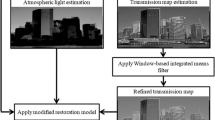Abstract
Ubiquitous visual surveillance is critical to public security. Unfortunately, adverse weathers, especially haze, degrade visual surveillance quality evidently, so dehazing is commonly used to limit the interference of haze. Unlike traditional dehazing methods that use various patch-based priors, non-local dehazing employs color index and regularization to estimate and refine initial transmission, respectively. However, currently non-local dehazing has not made the most of pixel neighborhood relation, so the edge details cannot be preserved powerfully. Since the gradient represents the difference between the adjacent pixels, the non-local dehazing algorithm is enhanced by color gradient in this paper. The color index and color gradient are jointly clustered to improve the accuracy of initial transmission. Finally the haze is removed according to the transmission refined by guided filter. The experimental results show that the proposed non-local dehazed algorithm enhanced by color gradient can effectively maintain the edge details and improve the performance of dehazing.






Similar content being viewed by others
References
Berman D, Avidan S (2016) Non-local image dehazing. IEEE Conference on Computer Vision and Pattern Recognition, 1674–1682
Chen C, Do MN, Wang J (2016) Robust image and video dehazing with visual artifact suppression via gradient residual minimization. European Conference on Computer Vision, p. 576–591
Choudhury SK, Sa PK, Bakshi S et al (2016) An evaluation of background subtraction for object detection vis-a-vis mitigating challenging scenarios. IEEE Access 4(99):6133–6150
Choudhury SK, Sa PK, Padhy RP et al (2017) Improved pedestrian detection using motion segmentation and silhouette orientation. Multimedia Tools Appl 6:1–40
Fang S, Wang F, Zhan Q et al (2012) Simultaneous dehazing and denoising of single hazing image. Pattern Recognit Artif Intell 25(1):136–142
Gonzalez CI, Melin P, Castro JR, et al (2015) Color image edge detection method based on interval type-2 fuzzy systems. Design of Intelligent Systems Based on Fuzzy Logic, Neural Networks and Nature-Inspired Optimization. Springer International Publishing, p. 3–11
Gonzalez CI, Melin P, Castro JR, et al (2017) Edge detection methods and filters used on digital image processing. Edge Detection Methods Based on Generalized Type-2 Fuzzy Logic. Springer International Publishing, p. 11–16
He KM, Sun J (2009) Single image haze removal using dark channel prior. IEEE Conf Comput Vis Pattern Recognit, p. 1956–1963
He K, Sun J (2015) Fast guided filter. Comput Sci 1–2
He K, Sun J, Tang X (2013) Guided image filtering. IEEE Trans Pattern Anal Mach Intell 35(6):1397–1409
Israni S, Jain S (2016) Edge detection of license plate using Sobel operator. International Conference on Electrical, Electronics, and Optimization Techniques, 3561–3563
Jiang B, Woodell GA, Jobson DJ (2015) Novel multi-scale Retinex with color restoration on graphics processing unit. J Real-Time Image Proc 10(2):239–253
Lim SH, Isa NAM, Ooi CH et al (2015) A new histogram equalization method for digital image enhancement and brightness preservation. SIViP 9(3):675–689
Meng G, Wang Y, Duan J, et al (2013) Efficient image dehazing with boundary constraint and contextual regularization. IEEE Int Conf Comput Vision, p. 617-624
Nanda A, Chauhan DS, Sa PK et al (2017) Illumination and scale invariant relevant visual features with hypergraph-based learning for multi-shot person re-identification. Multimedia Tools Appl 6:1–26
Narasimhan SG, Nayar SK (2001) Removing weather effects from monochrome images. IEEE Conf Comput Vis Pattern Recognit, p. 186–193
Narasimhan SG, Nayar SK (2002) Vision and the atmosphere. Int J Comput Vis 48(3):233–254
Narasimhan SG, Nayar SK (2003) Contrast restoration of weather degraded images. IEEE Trans Pattern Anal Mach Intell 25(6):713–724
Putra O V, Prianto B, Yuniarno E M, et al (2016) Visibility restoration of lake crater hazy image based on dark channel prior. International Computer Science and Engineering Conference, p. 1–6
Raman R, Choudhury SK, Bakshi S (2018) Spatiotemporal optical blob reconstruction for object detection in grayscale videos. Multimedia Tools & Applications 77(1):741-762
Ren W, Liu S, Zhang H, et al (2016) Single image dehazing via multi-scale convolutional neural networks. European Conference on Computer Vision, p. 154–169
Sun Y, Xiao L, Wei Z et al (2007) Method of defogging image of outdoor scenes based on PDE. J Syst Simulation 19(16):3739–3744
Wang YK, Fan CT (2014) Single image defogging by multiscale depth fusion. IEEE Trans Image Process 23(11):4826–4837
Yadav G, Maheshwari S, Agarwal A (2016) Multi-domain image enhancement of foggy images using contrast limited adaptive histogram equalization method. International Conference on Recent Cognizance in Wireless Communication Image Processing, p. 31–38
Zeng JX, Yu YL (2017) Image defogging and edge preserving algorithm based on dark channel prior bilateral filtering. J Image Graph 22(2):147–153
Zhang S, Qing C, Xu X, et al (2016) Dehazing with improved heterogeneous atmosphere light estimation and a nonlinear color attenuation prior model. 10th International Symposium on Communication Systems, Networks and Digital Signal Processing, p. 1–6
Zhu Q, Mai J, Shao L (2015) A fast single image haze removal algorithm using color attenuation prior. IEEE Trans Image Process 24(11):3522–3533
Acknowledgements
This work was supported by National Natural Science Foundation of China (61663031, 61741312, 61772255, 61763033), Key Research & Development Project of Jiangxi Province (20161BBE50085, 20171ACE50024), Construction Project of Advantage Scientific & Technological Innovation Team in Jiangxi Province (20165BCB19007), Construction Project of Advantage Scientific & Technological Innovation Team in Nanchang City, Application Innovation Program of Public Security Ministry (2017YYCXJXST048), Science and Technology Research Project of Education Department of Jiangxi Province (GJJ150715), Open Foundation of Key Laboratory of Jiangxi Province for Image Processing and Pattern Recognition (ET201680245, TX201604002), Ph.D Starting Foundation of Nanchang Hangkong University (EA201620045), Post-graduate Innovation Foundation of Jiangxi Province (YC2016021, YC2017095).
Author information
Authors and Affiliations
Corresponding author
Rights and permissions
About this article
Cite this article
Chu, J., Luo, J. & Leng, L. Non-local Dehazing enhanced by color gradient. Multimed Tools Appl 78, 5701–5713 (2019). https://doi.org/10.1007/s11042-018-5673-6
Received:
Revised:
Accepted:
Published:
Issue Date:
DOI: https://doi.org/10.1007/s11042-018-5673-6




